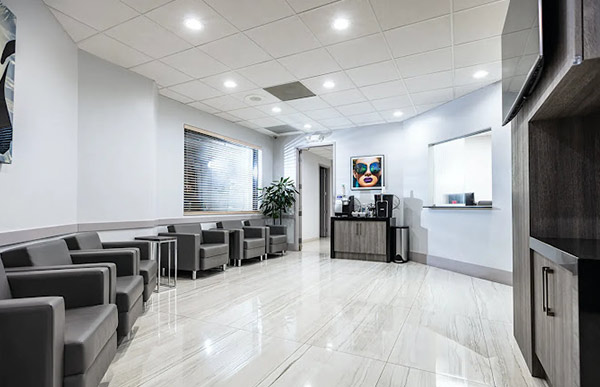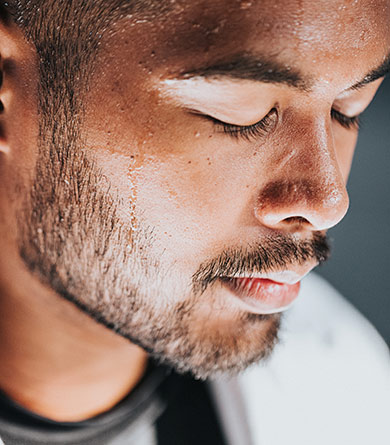Jump to this Section

What is Hyperhidrosis?
Everyone normally sweats while exercising, in anxiety-provoking situations, in a hot room. But what if you were drenched all the time – even in a cold room? Would you like to shake hands with someone whose hands are soaking wet with sweat?
Sweating is a normal process by which the body is able to cool itself. For unknown reasons, the part of the nervous system responsible for controlling body temperature can become dysfunctional and the result is exaggerated sweating, at variable (and often inopportune) times during the day and on various parts of the body. It is the nervous system which stimulates the excessive sweating – the sweat glands themselves are absolutely normal.
About 3% of the world population suffers from this condition, called hyperhidrosis, or excessive sweating. It affects both men and women, all races and ethnicities, teens and adults. Even young children and infants can have hyperhidrosis. And it runs in families, too, although many family members may not share that information with each other. People with hyperhidrosis produce up to five times the amount of sweat required to regulate body temperature. And as an added insult, the excess sweat that is produced is frequently acted upon by the normal bacteria on the skin surface to produce bad body odor (bromhidrosis).
How Does Hyperhidrosis Affect Daily Life?
The presence of hyperhidrosis takes a toll on day to day living – and it can ruin lives. One has to be ever vigilant, take several showers a day, remember to bring extra clothing in which to change during the course of a day, carry absorbent pads, etc. Clothing and shoes can be ruined, skin infections can occur, dry cleaning bills can skyrocket. Personal, social, and business plans have to be very carefully arranged to accommodate potential problems. Indeed, hyperhidrosis can affect one’s emotional, psychological, financial, physical, social, and even one’s professional life. It influences every decision and every moment. Hyperhidrosis is embarrassing and therefore no one talks about it – they suffer in silence. And unfortunately, many times patients do not seek adequate treatment because they do not know that treatment options actually exist.

Types of Sweat Glands

There are approximately four million sweat glands on the body – three million eccrine glands and one million apocrine glands. Eccrine sweat glands are contained entirely within the skin itself and are responsible for normal, casual-type sweating. These glands are distributed over the entire body but are concentrated on the forehead and soles of the feet, followed by the palms and the cheeks. The sweat produced is a thin, clear, odorless fluid.
Apocrine sweat glands, parts of which extend beneath the skin into the underlying fat, are responsible for the sweating associated with anxiety and hyperhidrosis. These glands are mainly located mainly in the hair-bearing areas of the armpits and the groin. They produce a thick, odorless sweat which is prone to rapid bacterial decomposition, which then leads to strong odors. It is the portions of these apocrine glands (the bulbs that produce the sweat itself) that extend into the fat beneath the skin that makes it possible for surgery to remove them. In the armpit areas, the ratio of eccrine to apocrine sweat glands is approximately one to one.
What Treatments Help with Excessive Sweating?
There are a number of treatment options for hyperhidrosis. Treatment should be directed towards correction, if possible, of the underlying causes.
It’s usually best to start with simple methods and then, if they fail, progress to more aggressive treatments.
Initially, one should consider antiperspirants, either over-the-counter (OTC) (e.g. Secret Clinical Strength) or by a doctor’s prescription (e.g. Hydrosal Professional). Deodorants merely deal with odor, not with the underlying perspiration problem. A combination of antiperspirants and deodorants may be a good starting treatment. Twice daily treatment is often helpful. Obviously, these treatments are only suitable for the armpit area.
For treatment of the hands and feet, iontophoresis may offer help. This 20 minute, painless treatment uses a water bath of electrolytes and chemicals in which a mild electric current is passed. The electric current forces the minerals and ions to plug up the sweat ducts. Usually, every other day treatment for six to ten treatments is required. Improvement may last for several weeks, at which time additional treatment is required. This treatment machine may be prescribed for home use.
Emotions also play a large role in sweating. Some natural therapies such as relaxation techniques, yoga, biofeedback, and psychotherapy are capable of breaking up the self-perpetuating cycle of heightened emotions leading to sweating which leads to anxiety about the sweating itself which leads to even more sweating. These techniques require multiple sessions and are not always totally effective.

Additional Treatments For Hyperhidrosis
Botulinum toxin (e.g. Botox, Dysport) injections have been successfully used for all areas – armpits, hands, feet, and face. There is mild discomfort during the injections which can be helped with numbing creams and ice packs. Since Botox works to block the nerve stimulation of the sweat glands, it works on both types of sweat glands to produce significant dryness. The improvements are apparent within days and oftentimes last for 4 – 12 months or longer – it is extremely variable. While there is no doubt that these injections are very helpful, the long-term cost of the treatments may be prohibitive.
Another treatment is with anticholinergic, anti-anxiety, anti-depressant, and other medications (such as Robinul, Inderal, Clonidine, etc). These are pills that affect a portion of the nervous system. They help to decrease anxiety and sweating over the entire body but by doing so, will affect the body’s natural ability to cool itself. Long-term use is not recommended due to the significant side effects of the medication.
When all else fails, surgery becomes an option. There are two alternatives: surgical sympathectomy and suction curettage.
A sympathectomy is an operation, performed under general anesthesia in a hospital, which cuts the sympathetic nerves to the armpit and palm areas. It is performed using minimal incisions and is known as ETS or endoscopic thoracic sympathectomy. Once this is performed, there is no way to reverse the operation. The operation interrupts the nerve stimulation to the sweat glands. Unfortunately, there is often post-operative compensatory sweating, in which the body switches the excess sweating to other areas of the body – and which may be worse than the original problem. This can occur even years after the original surgery.
A new and relatively simple surgical procedure for hyperhidrosis of the armpits (“Sweat Lipo” surgery) has recently been developed and perfected by Dr. Jacobs. It is performed in a 45-minute operation under sedation and local anesthesia on an out-patient basis in our fully accredited hospital-type office operating room suite. The procedure uses specialized, sharp instruments designed by Dr. Jacobs to perform a direct removal of the sweat glands of the armpit areas. Technically, it is called suction curettage, although it goes by the easily remembered term “Sweat Lipo.”
Ideal Candidates for Hyperhidrosis Treatment
Candidates for hyperhidrosis treatment may include those who experience the following:

Excessive sweating for longer than 6 months, happening at least once a week

Sweating that interferes with daily activities

Excessive sweating is that occurs on both hands, feet, or armpits

A family history that includes excessive sweating
What to Expect from Recovery
Dr. Jacobs provides his patients with a specific set of instructions to follow during the recovery period. Careful adherence to these instructions will help ensure a positive outcome after the surgery.


Benefits of Hyperhidrosis Treatment
- It’s fast acting
- There are non-invasive options
- It restores self-confidence
- It’s versatile for many areas
Risks of Hyperhidrosis Treatment
Depending on the treatment option chosen, you may experience different symptoms or side effects. These should pass quickly and all questions can be discussed with Dr. Jacobs.


Why Choose Dr. Jacobs for Hyperhidrosis Treatment?
Dr. Jacobs is a board-certified plastic surgeon who specializes in many forms of treatment to get rid of excessive sweating. He can help you become more comfortable in your own skin. Call or email today to schedule your consultation.
Contact UsContact Us
Reach out to Dr. Jacobs today to schedule your consultation!
Frequently Asked Questions

Are there different types of hyperhidrosis?
Primary (focal) hyperhidrosis, oftentimes starting around puberty, is excessive sweating which is not caused by another medical condition. Most commonly, the armpits (technically called the axillae), the hands, the feet, and the groin are involved. Occasionally, the face, back, and chest are also affected. The sweating is usually symmetric (ie. both sides equally affected) and rarely occurs while sleeping.
Secondary hyperhidrosis is excessive sweating as a side effect of another medical condition, such as menopause, cancer, diabetes, or taking some medications. It often occurs while sleeping.
What is “Sweat Lipo”?
“Sweat Lipo” surgery can only be performed only in the armpit areas. A single, 1/8 inch incision is made at the front of the armpit crease. The instrument is inserted and directed towards the undersurface of the armpit skin. Strong suction is applied and then, with a combination of suction and sharp scraping against the skin’s undersurface, the bulbs of the apocrine glands (which produce the sweat) are removed. The result is that the apocrine glands will be rendered inoperative. However, the eccrine glands in the treated areas will remain intact and continue to function. Therefore, a significant reduction – but not total elimination – of sweating will occur.
“Sweat Lipo” surgery for hyperhidrosis is performed under sedation anesthesia which is administered by a separate, board certified, MD anesthesiologist. There is absolutely no pain or awareness during the procedure. You will awaken quickly after surgery, with no nausea, grogginess, sore throat or hangover. The wounds are closed with a single, dissolving suture. This results in a small scar which, in time, becomes nothing more than a blemish. Dressings will be applied after surgery and worn for only 2-3 days. There is minimal discomfort (mild soreness) after surgery – usually handled by simple Tylenol pills. Most patients are back to sedentary work within a day or two.
One may expect some swelling, bruising, and numbness of the skin – all of which are temporary and will disappear within one to two weeks.
There is usually a significant decrease in sweating within a few days after surgery.


